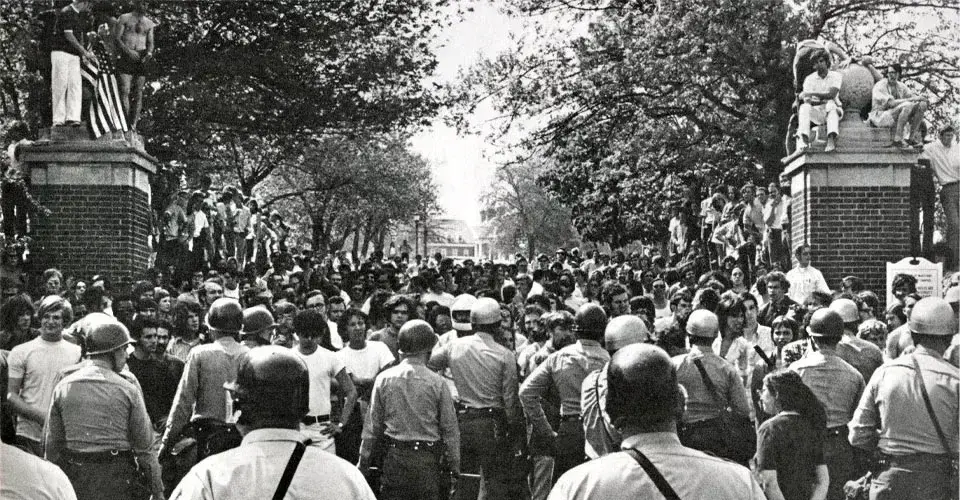50 Years After Protests Rocked UMD, Their Legacy Remains
By Sala Levin ’10 | Photos courtesy of University ArchivesMay 1, 1970: Route 1 is packed curb to curb with protesters facing a line of police officers, riot batons at the ready. Eventually, tear gas canisters, bottles, eggs and rocks arc through the air.
President Nixon’s announcement of U.S. troops invading Cambodia had pushed simmering tensions over civil rights injustices, gender inequities and administrative missteps at Maryland to the boiling point. Though the turmoil of the 1960s had been shaking campuses like the University of California, Berkeley and Columbia University for years, demonstrations at UMD were small-scale until now.
By the time the protest era subsided, Maryland had rounded a turning point with a loosening of cultural norms and lasting changes in policy, as well as experiences that continue to resonate for many alumni.
Back then, physics Distinguished University Professor Jordan Goodman ’73, M.S. ’75, Ph.D. ’78 was an undergraduate documenting rallies and clashes with law enforcement with his camera. “The draft hung over people’s heads,” he says. “It wasn’t that someone else was going to go fight a war—they could call you to go fight this war. People you knew were going to fight the war.”
In March, 87 people were arrested for staging a sit-in at the Skinner Building to protest two professors being denied tenure. On the first day of May, what started with a rally in front of McKeldin Library led to vandalism at Reckord Armory, home of the ROTC program, and eventually, a rush on Route 1. The conflict between students, police and National Guard troops lasted on and off for much of the month, a period that included the fatal National Guard shooting at Kent State University.
In the months and years that followed, life on campus took on a different tone—less formal, more radicalized and with an increased role in governance for students. “In loco parentis, where the administration is acting as a parent, really falls apart at this point,” says Anne Turkos, university archivist emerita.
Anti-establishment principles weakened Greek life, too, which lost much of its prominence in the 1970s. “It was seen as you weren’t an independent thinker if you were part of the Greek system; you were a follower,” says Arlene Gerst ’70, who was a sister in Delta Phi Epsilon.
Female students—previously bound by a restrictive code of conduct—began enjoying greater freedom in the post-protest era. Emboldened by the cultural shift, Turkos says, “women finally just said, ‘We’re not going to do this anymore.’” Curfews, bed checks and suggestions for how to dress disappeared.
A demand for racial equity was also a high priority. “The connection between the struggle against racism at UMD and the struggle against the war was very significant for me,” says Greg Dunkel Ph.D. ’67, who was active in Students for a Democratic Society. Students pushed for higher enrollment of people of color, and increased hiring of faculty and staff of color, says Turkos.
Goodman hopes that today’s students feel the empowerment and urge to rebel that his contemporaries did. “You had a feeling that you could change the world, and maybe by a little bit we did,” he says. “In every generation you have to do that, or it doesn’t stick.”
Issue
Spring 2020Types
Campus Life
David Tamanini
2 years ago